An introduction and history for the fast food industry in Canada
Canadian fast food industry is a lucrative industry to investors due to its non-intermittent growth; moreover, this industry started its operation at the very beginning of the industrial age and gained more and more consumers from its inception at the early 19th century.
The growth rate of this industry has been shrinking for few years, projecting the maturity of the industry; however, it experiences continuous growth because the customers are mainly concentrate on four factors including quickness (time to prepare food), convenience (easily reachable), lower price (competitive price), and taste (flavour).
Reiter (2010) stated that general tradition to gather around a table at home to share meal become outdated concept for many inhabitants and the site of meal consumption is changing as well (39.7 cents of every food dollar was spent on fast food restaurants); therefore, teenagers are to be found at the local fast-food outlets as customers and workers.
However, Reiter (2010) further stated that about three million people (10% of total population) in this country visit McDonalds’ restaurants daily; consequently, several British and American centric companies and brands have been holding major market shares in Canadian fast food market.
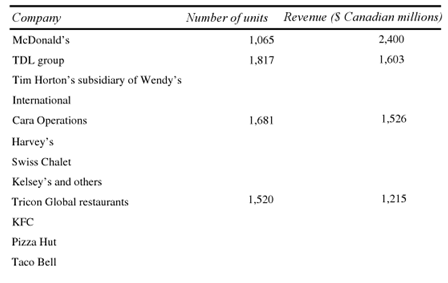
Slcfred (2011) stated that Mcdinalds had more than 31000 outlets all over the world, among them 5% restaurants or 1550 outlets are in Canada and highest 50% restaurants are in the USA; however, the following two figures give more details in this regard
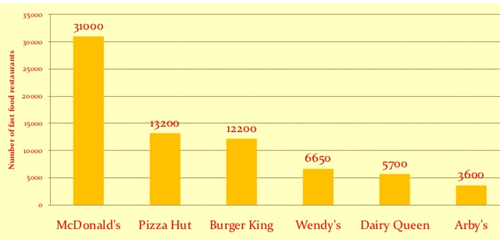
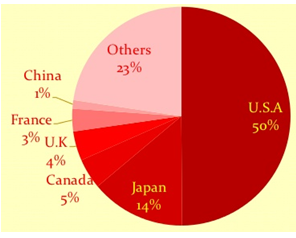
Nowadays, the people of Canada mostly prefer fast food instead of fruits and vegetables and they usually not take balanced diet; therefore, the national and international companies in this industry would like to expand business in this zone, for example, McDonalds occupied 43.5% outlets and the following figure shows more information about the fast food outlets of McDonalds-
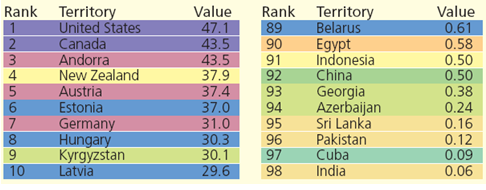
History of Canadian Fast-Food Industry
During nineteenth century the fast-food industry of Canada started its journey under the leadership of discriminated immigrant people of different ethic groups and local females migrated in the urban areas with a large number of small entrepreneurs, but large fast-food chains like Murray’s, Fran’s and even Diana Sweets were established during the period of nineties twenties.
The fast-food industry grew up with the rising number of immigrants with low wage and long working hours and the continuous exploitation drove the workers to unite under the leftist political alignment, during the depression of thirties, the workers movement of the fast-food, hotel, and restaurants had organized several strikes with the demand of less working hours and sustainable wages.
During the years of World War-II, the Canadian economy flourished with the highest flow of foreigners and the fast-food industry enjoyed a golden days with tremendous sales revenue, but faced a challenge to sustain the industry next to the war end and looked for new way to finding the market for ready to take foods.
During sixties and seventies, the fast-food industry of Canada flourished into chain shops, and gained corporate structure with a new form of franchising business that turned the major industry players to establish their own outlets all over the country and even worldwide (Reiter, 2010, p. 32).
The economical aspects for this industry
The fast food industry in Canada is an extremely attractive business sector in terms of profitability; as a result, it remains an appealing market for the global giants, the industry to contribute significantly in the country’s GDP.
According to Euromonitor (2012), the Canadian fast-food industry is expected to develop with steady value of Compound Annual Growth Rate of two percent throughout this period to attain sales of CAD 23.6bn by 2016; in addition, it is anticipated that the outlet-numbers will amplify to 37804 by 2016; moreover, independent fast food locations will grow marginally faster than chained locations.
On the other hand, even though patrons had a transformation buy to cheaper foods due to lack of purchasing power during the financial crisis, in 2010, Canadian fast food sales still totaled $20.4 bn; however, now the consumer-confidence is progressively recurring, so the growth is expected to increase further and this drift is anticipated to persist throughout the upcoming years.
IBIS World (2010) suggested that McDonald’s the first global-store was launched in Canada, and today, the corporation holds a strong position in the country; for the Canadian and American market, the corporation’s “owned” and “franchised-stores” revenues increased ten percent to $1,743m; however analogous store revenues was merely 0.4 percent and returns from these operations was down to two percent ($348.2m).
Greater unemployment and profound price cuts by rivals adversely affected the corporation; however, over the 12 months to the end of March 2008, there was a net increase of fourteen outlets and it acquired twenty franchised-outlets; it is notable that during that time, the number of stores in the US and Canada were 7497 (918 owned company and 6579 franchised).
In 2006, in the US and Canada, total-sales of Burger-King amplified as it obtained eighteen franchised-restaurants throughout the year; however, the number of restaurants in this market diminished to 46 representing 92-openings counterbalanced by 138 shut-downs; conversely, it had 878 company-owned-stores in the US and Canada at the end of 2006, and supplementary 6656 franchised-stores making a total of 9,889 outlets.
On the other hand, Domino’s experienced noteworthy extension in Canada in 1983; however, the following figure shows a comparative chart of the market share of different companies in the fast food industry:

OSEC (2011) has suggested that recently consumers in the Canadian market are spending significantly in the fast food industry, making it a prospective sector in terms of economy for the next few years; this tendency is notable from the graph below.
The graph shows the spending by category of consumers in the Canadian market and states that about eleven per cent people in the country spends more in eating out of home –
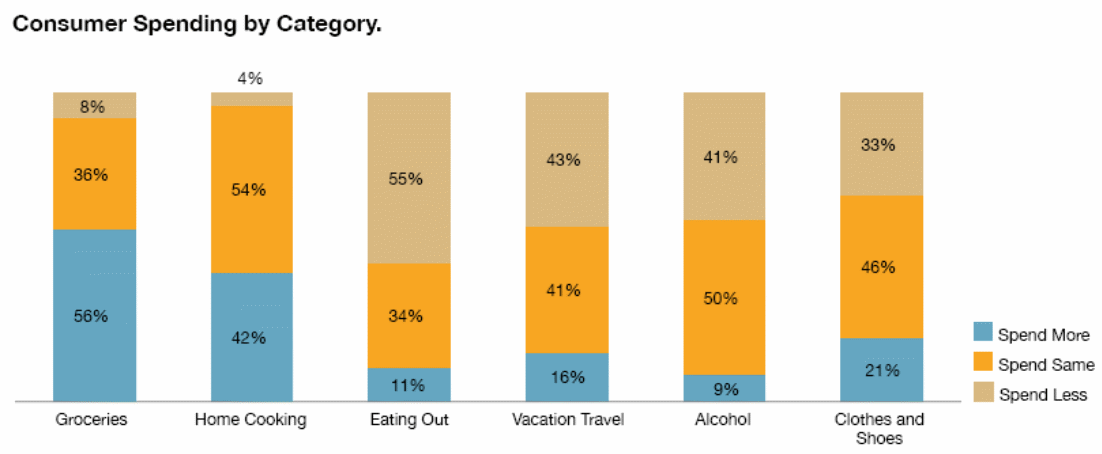
The following figure shows the percentage of total sales by segment in Canada:
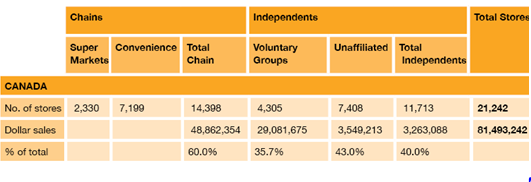
O’Leary, Eberts & Pittelko (2012) stated that starting business in Canada is easy for the US fast food companies due to flexible provisions of NAFTA, for instance, the government of this country reduces tariff, improve job market, decrease trade barriers; in addition, agreement between Canada and EFTA countries help the fast food companies to expert raw materials without custom duties.
RAPS (2012) reported that top two hundred Canadian fast food restaurants sale more than $19.60 billion within nine months, which gives the opportunity to start business in new place like Australia; however, most of the companies concentrate more on the affordable price for upscale menu to create loyal customer base.
According to Reiter (2010, p. 39), labour turnover in this industry is estimated at 300% per year because the workers have limited options to get support from the local regulation and entrepreneurs of the business; however, trade unions identified that owners fire the employees within three hours if they object any provisions.
Challenges and limitations for this industry
Salty food and awareness of the people
Schmidt (2012) reported that the main challenge of this industry is to reduce salt levels from Canadian fast food industry though salt levels in fast foods varied considerably in different states; however, Weeks (2012) conducted a survey for ‘the Globe and Mail’ and collected data related this issue from renowned fast food restaurants like Burger King, Domino’s Pizza, etc.
Most of the restaurants had cooperated to conduct survey to measure salt levels in the food to face the challenge of sodium reduction, but McDonald’s had denied to co-operate to the Globe and Mail in this regard; however, the surveyor also compared 2,100 Canadian fast food items with other countries’ (New Zeland, the UK and the US) food items.
The survey of the Globe and Mail considered the 151 salads items and found that Canadian salads item includes an average 320mg / 100g serving while other countries use (100 – 200) mg / 100g; in addition, Schmidt (2012) reported that French fries sold at major fast food chains, which contains double salt; however, subsequent table gives more detail –
However, Canadians are not conscious to reduce salt use in their foods, which influences the fast food companies (like McDonalds, Burger King, Kentucky Fried Chicken, Pizza Hut and Subway and so on) to prepare food in accordance with their taste, but this practice can pressure the government to pass new law to protect public health.
Labour Relations
Implementation of labour law is a challenging factor because federal government has jurisdiction over only 10% of the workforce, which gives the opportunity to the labours to consider different province regulation to bargain collective interest, minimum salary and standards; however, the staff turnover rate is too high though young labours of small outlets have limited knowledge of predominate (Reiter, 2010).
One of the major challenges for this industry is the relationship between labour and employees while both parties have significant complaints against each other; for example, the labours particularly part-time workers are not satisfied with the environment of the workplace and remuneration policy, terms and conditions of contracts, and behaviour of the entrepreneurs (Reiter, 2010, p. 39).
Market Competition
The fast food market became saturate and highly competitive because there are too many companies enter this market considering the consumption rate and profitability level in this sector; however, there are several national brands doing very well, but they are not enough strong to compete with global brands like McDonalds, KFC, Taco Bell, Wendy’s, Burger King, etc.
Risk Assessment Index
IBIS World (2010, p.35) reported that operating conditions in the Fast Food Restaurants industry are more hazardous considering the following issues in the figure
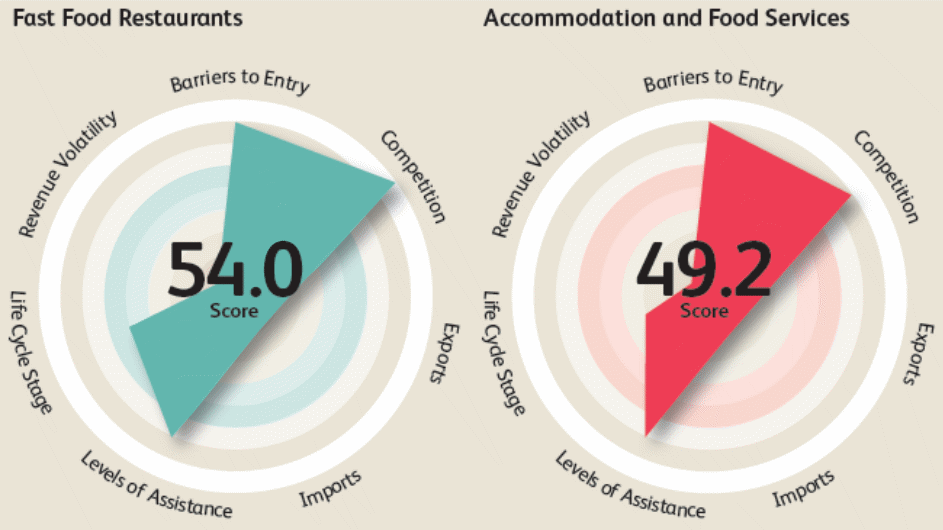
Financial Downturn
IBIS World (2010) and OSEC (2011) reported that fast food industry has faced a major slowdown because of global financial crisis and changing customer behaviour about the food value; the overall sales revenue from this industry decreased by more than 3.30% in 2009 and growth rate reduced by 0.40% though the researchers estimated above 3%. Therefore, this report considered market slowdown for financial crisis as a major challenge for this industry
Challenges in Packaging Waste Management
Aarnio (2006) argued that eating habits of the people have changed over time and they are now rely more on the fast food restaurants to save their time and effort, but the people and management of the companies often overlook the packaging waste legislation the environmental degradation would generate ecological imbalance and hamper socioeconomic development.
Consequently, it is one of the significant factors to this industry; however, the government and local administration have already taken waste management projects, but the companies should have consider the issue of corporate responsibility towards the environment, so, they can put composting bins outside each outlet with intent to gather waste materials to make organic fertilizers or other products.
Reference List
Aarnio, T. (2006). Challenges in Packaging Waste Management: A Case Study in the Fast Food Industry. Web.
Euromonitor. (2012) Fast Food in Canada. Web.
IBIS World. (2010). Fast-food fallout: Health-conscious and cash poor consumers serve as an industry challenge. Web.
Newman, M. (2004). International Fast Food. Web.
OSEC. (2011). The Canadian Food Retail Sector. Web.
RAPS. (2012). Fast Food Environmental Scan 2012. Web.
Reiter. E. (2010). Fast food in Canada. Web.
Schmidt, S. (2012). Salty fast food: Canada has saltiest fries, sandwiches, and salads. Web.
Weeks, C. (2012). Canada’s fast food some of the saltiest in the world. Web.